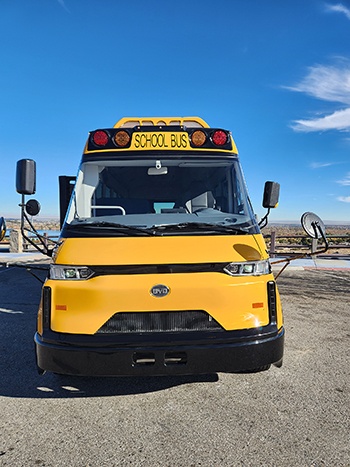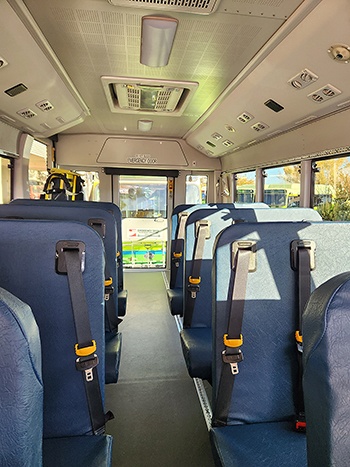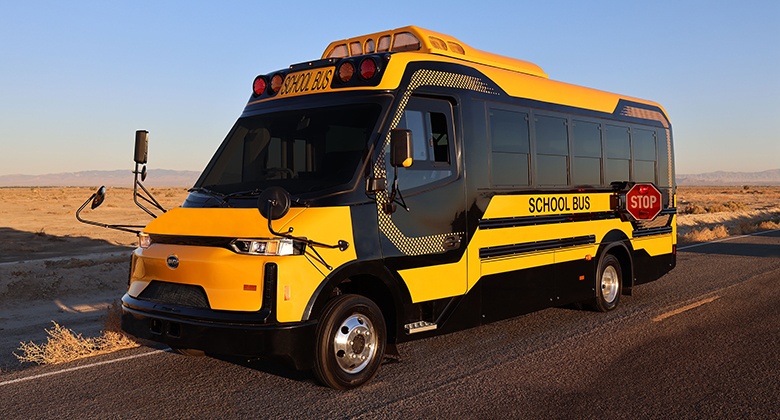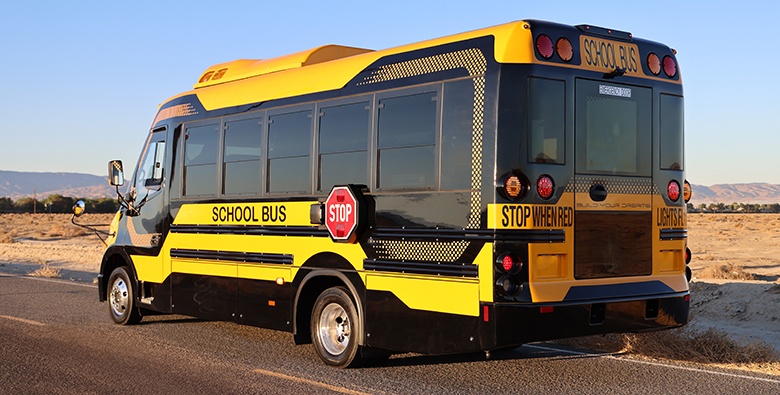
Santa Cruz City Schools is somewhat unique in the state of California, in that it is comprised of two school districts governed by a single school board. Consisting of three high schools, two middle schools, four elementary schools, a continuation school, and charter school in Santa Cruz County, its transportation department also handles special needs/special day classes for all the county’s schools.
Emil Frates, transportation supervisor for the district, said the district has upgraded its fleet over the past nine years. It now stands at eight electric buses, plus 12 additional vehicles running on either diesel or gasoline.
 The Type A by RIDE
The Type A by RIDE
Santa Cruz City Schools recently took delivery of three 26.7-foot Type A all-electric school buses from RIDE, utilizing a mix of grant awards, matching funds from the Monterey Bay Air Resources District’s Hybrid and Zero-Emission Truck and Bus Voucher Incentive Project (HVIP), as well as Central Coast Community Energy (3CE).
RIDE’s Type A features vehicle-to-grid (V2G) technology, which lets the bus serve as a clean-energy power source for districts whenever it is not in use. RIDE representatives said the bus has up to 60 percent lower maintenance and energy costs compared to its competitors. The iron-phosphate batteries, which RIDE touts as some of the industry’s safest, include a 12-year warranty for districts – ensuring cost-free battery replacement for the vehicle’s standard service life.
With a top speed of 65 miles per hour and a range of 105 miles, the Type A is perfect for smaller and midsized districts looking to optimize routing for its students. In addition to the standard 26.7-foot design, 24.6-foot and 22.9-foot options are available.
Santa Cruz City Schools opts for RIDE
The 30-passenger vehicles are in the process of being certified for service, but Frates said the district was drawn to the buses’ unique platform and driver-friendly layout.
“When we’re dealing with special needs students, the design is critical,” Frates said. “Most electric vehicles (EVs) we encounter are designed as a chassis with a box added. So, we’ll often see an E-450 chassis, with a box added by the bus manufacturer. The driver is in a sort of doghouse, where it’s hard to spin around, get up, and work with the kids.”
“What I like about the RIDE bus is that it’s a nice flat platform you can walk up to,” he continued. “It is commercial grade and will be very advantageous for our drivers—as well as our students—because they’re up high and can see really well out of it.”

Frates said the district was impressed that the Type A bus is configured for its drivers, who often need to exit their seat to help special needs children buckle up or to assist aides.
“We also found it interesting that the bus features a driver’s side door,” he said. “It’s unusual, but it’s really wonderful because it gives them a different way to enter and exit the bus. The driver controls are very straightforward, which is another great feature for our drivers.”
Frates added that the vehicle has performed exceptionally during the district’s test drives thus far, including handling highway speeds well.
 The district often takes special-needs students to day classes at the elementary, middle, and high schools, as well as across the county – after which the buses turn around and return to the office. The transportation department also provides field trip service, and so the 30-passenger layout is a perfect fit for the district’s average classroom size.
The district often takes special-needs students to day classes at the elementary, middle, and high schools, as well as across the county – after which the buses turn around and return to the office. The transportation department also provides field trip service, and so the 30-passenger layout is a perfect fit for the district’s average classroom size.
“We’ll be able to ‘run the wheels off’ these buses by taking kids to school, doing the day trips for elementary, middle, and high school, and then transporting the kids back home in the afternoon,” Frates said, indicating the buses will see high usage on the district’s fixed and special routes. “We’re really looking forward to using these quite a bit.”
Upon delivery of the first vehicle, RIDE deployed a trainer to Santa Cruz City Schools who spent six hours educating the district’s drivers and maintenance techs on the nuances of the bus and its operation.
“It was really well-documented,” Frates said. “The engine on the Type A has been in service with commercial trucks for more than five years, so it is a proven platform. The trainer showed us everything we need to watch out for, and how to maintain the bus.”
Frates added that the batteries are very accessible, and that the vehicle features a reliable air compressor and air brakes for added safety. Finally, he complimented the vehicle’s lighting and easy-to-navigate interior layout.
“It seems to be a well-thought-out design, and overall, just a great bus,” he said.

Preparing for Service
Frates said that the district has 11 bus routes and plans to utilize its electric vehicles (including the three RIDE Type A buses) as much as possible – only using the diesel and gas vehicles as backups when necessary.
The district has not yet fully completed its EV infrastructure installation, due to some material shortages as well as needing to prioritize certain other district projects. That said, Frates is confident that infrastructure implementation will progress smoothly soon.

“We have been planning this for several years, which sets us up well for installation,” he said. “We have a place designated for the transformer. By September, we should have 10 charging stations. That will accommodate our current fleet, and by that time we should also have 10 electric vehicles in total.”
Frates added that he is excited to see the students’ reaction to the new Type A electric buses. For field trips, it will mean a transition from parent-aided transportation into a fully yellow bus experience.
“It’s a great experience,” he said. “For little ones, like the kids in kindergarden, it’s an adventure on the yellow bus. Whether it’s visiting a pumpkin patch on Halloween, or visiting the Dimeo Lane Resource Recovery Facility here in Santa Cruz, these 30-passenger buses are going to be a big hit next year. It’s going to be really exciting.”


